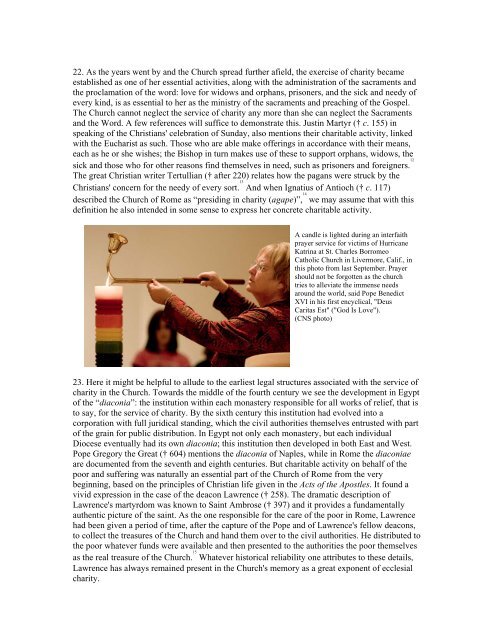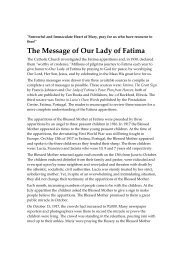ecognizing the plan of the Father who, moved by love (cf. Jn 3:16), sent his only-begotten Soninto the world to redeem man. By dying on the Cross—as Saint John tells us—Jesus “gave up hisSpirit” (Jn 19:30), anticipating the gift of the Holy Spirit that he would make after hisResurrection (cf. Jn 20:22). This was to fulfil the promise of “rivers of living water” that wouldflow out of the hearts of believers, through the outpouring of the Spirit (cf. Jn 7:38-39). TheSpirit, in fact, is that interior power which harmonizes their hearts with Christ's heart and movesthem to love their brethren as Christ loved them, when he bent down to wash the feet of thedisciples (cf. Jn 13:1-13) and above all when he gave his life for us (cf. Jn 13:1, 15:13).The Spirit is also the energy which transforms the heart of the ecclesial community, so that itbecomes a witness before the world to the love of the Father, who wishes to make humanity asingle family in his Son. The entire activity of the Church is an expression of a love that seeks theintegral good of man: it seeks his evangelization through Word and Sacrament, an undertakingthat is often heroic in the way it is acted out in history; and it seeks to promote man in the variousarenas of life and human activity. <strong>Love</strong> is therefore the service that the Church carries out in orderto attend constantly to man's sufferings and his needs, including material needs. And this is theaspect, this service of charity, on which I want to focus in the second part of the Encyclical.Charity as a responsibility of the Church20. <strong>Love</strong> of neighbour, grounded in the love of <strong>God</strong>, is first and foremost a responsibility for eachindividual member of the faithful, but it is also a responsibility for the entire ecclesial communityat every level: from the local community to the particular Church and to the Church universal inits entirety. As a community, the Church must practise love. <strong>Love</strong> thus needs to be organized if itis to be an ordered service to the community. The awareness of this responsibility has had aconstitutive relevance in the Church from the beginning: “All who believed were together andhad all things in common; and they sold their possessions and goods and distributed them to all,as any had need” (Acts 2:44-5). In these words, Saint Luke provides a kind of definition of theChurch, whose constitutive elements include fidelity to the “teaching of the Apostles”,“communion” (koinonia), “the breaking of the bread” and “prayer” (cf. Acts 2:42). The elementof “communion” (koinonia) is not initially defined, but appears concretely in the verses quotedabove: it consists in the fact that believers hold all things in common and that among them, thereis no longer any distinction between rich and poor (cf. also Acts 4:32-37). As the Church grew,this radical form of material communion could not in fact be preserved. But its essential coreremained: within the community of believers there can never be room for a poverty that deniesanyone what is needed for a dignified life.21. A decisive step in the difficult search for ways of putting this fundamental ecclesial principleinto practice is illustrated in the choice of the seven, which marked the origin of the diaconaloffice (cf. Acts 6:5-6). In the early Church, in fact, with regard to the daily distribution to widows,a disparity had arisen between Hebrew speakers and Greek speakers. The Apostles, who had beenentrusted primarily with “prayer” (the Eucharist and the liturgy) and the “ministry of the word”,felt over-burdened by “serving tables”, so they decided to reserve to themselves the principal dutyand to designate for the other task, also necessary in the Church, a group of seven persons. Norwas this group to carry out a purely mechanical work of distribution: they were to be men “full ofthe Spirit and of wisdom” (cf. Acts 6:1-6). In other words, the social service which they weremeant to provide was absolutely concrete, yet at the same time it was also a spiritual service;theirs was a truly spiritual office which carried out an essential responsibility of the Church,namely a well-ordered love of neighbour. With the formation of this group of seven,“diaconia”—the ministry of charity exercised in a communitarian, orderly way—became part ofthe fundamental structure of the Church.
22. As the years went by and the Church spread further afield, the exercise of charity becameestablished as one of her essential activities, along with the administration of the sacraments andthe proclamation of the word: love for widows and orphans, prisoners, and the sick and needy ofevery kind, is as essential to her as the ministry of the sacraments and preaching of the Gospel.The Church cannot neglect the service of charity any more than she can neglect the Sacramentsand the Word. A few references will suffice to demonstrate this. Justin Martyr († c. 155) inspeaking of the Christians' celebration of Sunday, also mentions their charitable activity, linkedwith the Eucharist as such. Those who are able make offerings in accordance with their means,each as he or she wishes; the Bishop in turn makes use of these to support orphans, widows, thesick and those who for other reasons find themselves in need, such as prisoners and foreigners. 12The great Christian writer Tertullian († after 220) relates how the pagans were struck by theChristians' concern for the needy of every sort. 13 And when Ignatius of Antioch († c. 117)described the Church of Rome as “presiding in charity (agape)”, 14 we may assume that with thisdefinition he also intended in some sense to express her concrete charitable activity.A candle is lighted during an interfaithprayer service for victims of HurricaneKatrina at St. Charles BorromeoCatholic Church in Livermore, Calif., inthis photo from last September. Prayershould not be forgotten as the churchtries to alleviate the immense needsaround the world, said Pope BenedictXVI in his first encyclical, "DeusCaritas Est" ("<strong>God</strong> <strong>Is</strong> <strong>Love</strong>").(CNS photo)23. Here it might be helpful to allude to the earliest legal structures associated with the service ofcharity in the Church. Towards the middle of the fourth century we see the development in Egyptof the “diaconia”: the institution within each monastery responsible for all works of relief, that isto say, for the service of charity. By the sixth century this institution had evolved into acorporation with full juridical standing, which the civil authorities themselves entrusted with partof the grain for public distribution. In Egypt not only each monastery, but each individualDiocese eventually had its own diaconia; this institution then developed in both East and West.Pope Gregory the Great († 604) mentions the diaconia of Naples, while in Rome the diaconiaeare documented from the seventh and eighth centuries. But charitable activity on behalf of thepoor and suffering was naturally an essential part of the Church of Rome from the verybeginning, based on the principles of Christian life given in the Acts of the Apostles. It found avivid expression in the case of the deacon Lawrence († 258). The dramatic description ofLawrence's martyrdom was known to Saint Ambrose († 397) and it provides a fundamentallyauthentic picture of the saint. As the one responsible for the care of the poor in Rome, Lawrencehad been given a period of time, after the capture of the Pope and of Lawrence's fellow deacons,to collect the treasures of the Church and hand them over to the civil authorities. He distributed tothe poor whatever funds were available and then presented to the authorities the poor themselvesas the real treasure of the Church. 15 Whatever historical reliability one attributes to these details,Lawrence has always remained present in the Church's memory as a great exponent of ecclesialcharity.












